1993 CHEVROLET CAMARO warning lights
[x] Cancel search: warning lightsPage 11 of 358
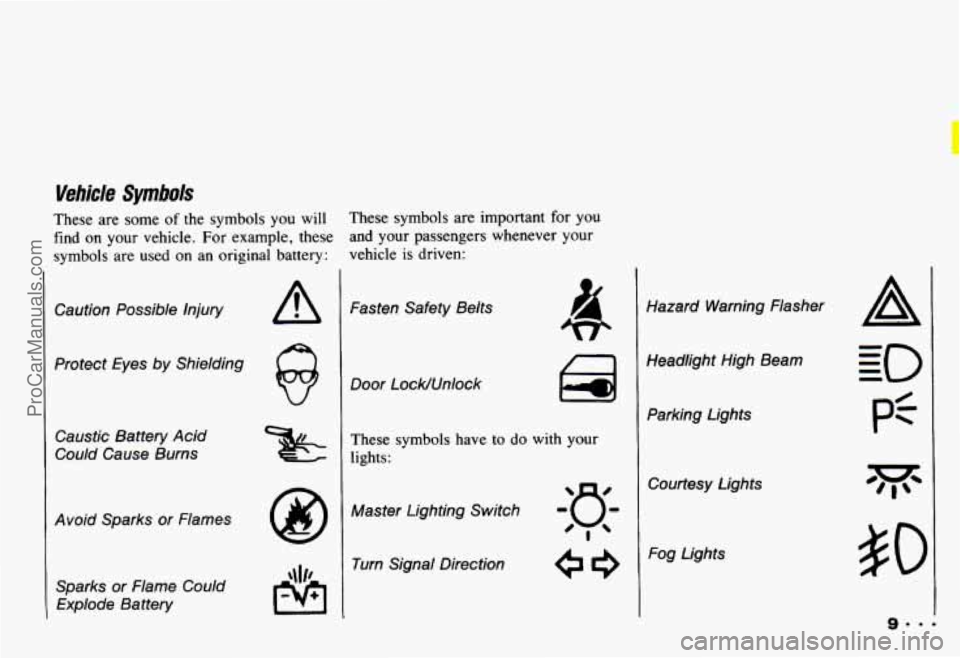
I
Vehicle Symbok
These are some of the symbols you will
find on your vehicle. For example, these
symbols are used on an original battery: These symbols are important for you
and your passengers whenever your
vehicle
is driven:
Caution Possible Injury
Protect Eyes by Shielding
Caustic Battery Acid
Could Cause Burns
Avoid Sparks or Flames
Sparks or Flame Could
Explode Battery Fasten Safety Belts
Door LocWUnlock
These symbols have to do with your
lights:
Master Lighting Switch
Turn Signal Direction Hazard
Warning Flasher
Headlight High Beam
Parking Lights
Courtesy Lights
Fog Lights
pf
%O
9.. .
ProCarManuals.com
Page 12 of 358
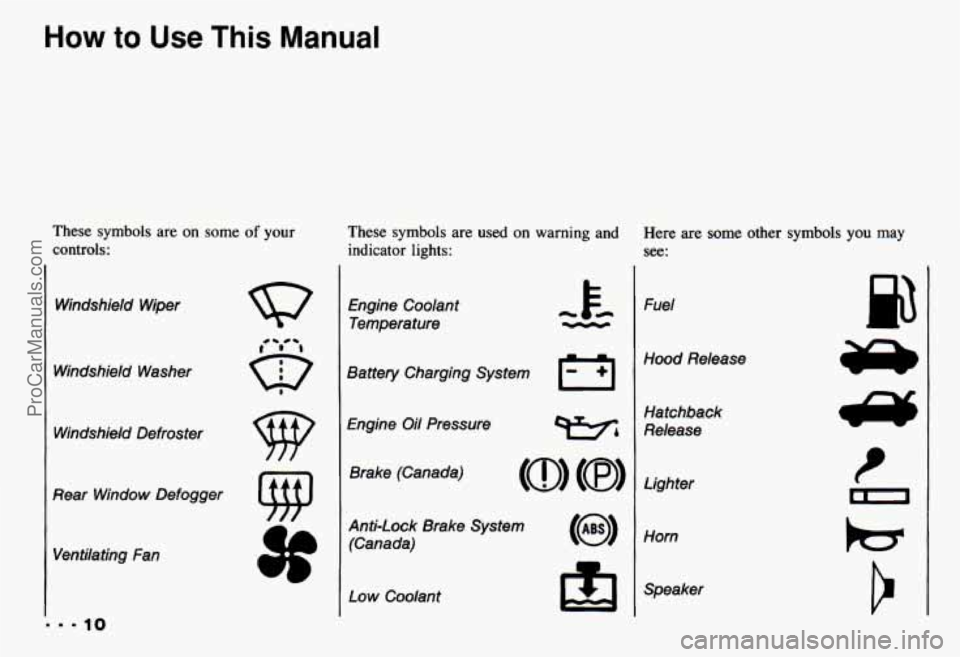
How to Use This Manual
These symbols are on some of your
controls: These symbols are used
on warning and
indicator lights:
Windshield Wiper
Windshield Washer Windshield Defroster
0
9
0-
I
Rear Window Defogger Ventilating Fan Engine Coolant
Temperature
Battery Charging System
El
Engine Oil Pressure Brake (Canada)
Anti-Lock Brake System (Canada)
Low Coolant h
Here are some other symbols you may
See:
Fuel
Hood Release
Hatchback
Release
Lighter
Horn
Speaker
p3
ProCarManuals.com
Page 14 of 358
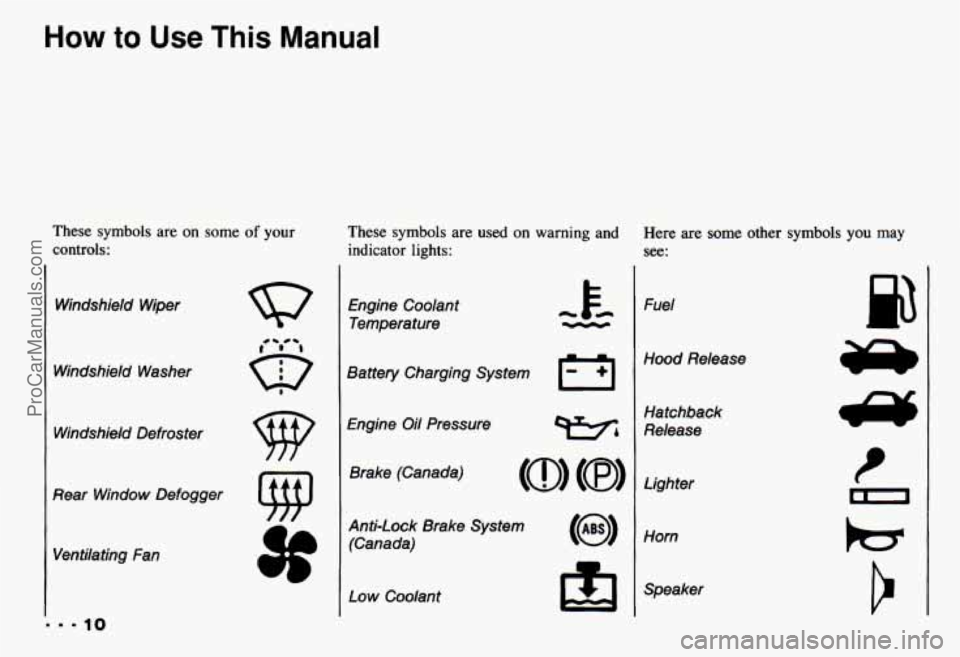
How to Use This Manual
These symbols are on some of your
controls: These symbols are used
on warning and
indicator lights:
Windshield Wiper
Windshield Washer Windshield Defroster
0
9
0-
I
Rear Window Defogger Ventilating Fan Engine Coolant
Temperature
Battery Charging System
El
Engine Oil Pressure Brake (Canada)
Anti-Lock Brake System (Canada)
Low Coolant h
Here are some other symbols you may
See:
Fuel
Hood Release
Hatchback
Release
Lighter
Horn
Speaker
p3
ProCarManuals.com
Page 51 of 358

Part 2
Features & Controls
Keys .............................................................. 48
.... DoorLocks ......................................................... 50
Theft .............................................................. 52
Here you can learn about the
many standard and optional
features on your Chevrolet. and
information
on starting. shifting
and braking
. Also explained are
the instrument panel and the
warning systems that tell you if
everything is working properly
-
and what to do if you have a
problem .
PASS-Key II@ ...................................................... 53
New Vehicle "Break-In" .............................................. 55
Ignitionswitch ...................................................... 55
Starting Your Engine ................................................. 57
Driving through Deep Standing Water
.................................... 61
Engine Block Heater
................................................. 61
Automatic Transmission .............................................. 62
ManualTransmission ................................................. 66
Limited-Slip Rear Axle
............................................... 70
Parking
............................................................ 70
EngineExhaust
..................................................... 74
Windows
.......................................................... 75
Horn
.............................................................. 76
Tiltwheel
.......................................................... 76
Operation of Lights
.................................................. 84
Interior Lights ...................................................... 86
Mirrors ............................................................ 87
Twin Lift-off Roof Panels
............................................. 88
Storage and Compartments ............................................ 92
Sunvisors
......................................................... 94
Ashtray and Lighter .................................................. 94
FloorMats ......................................................... 95
Instrument Panel and Cluster ........................................... 98
Warning Lights
. Gages and Indicators .................................... 99
47
The Turn Signal/Headlight Beam Lever .................................. 77
ProCarManuals.com
Page 59 of 358

Off (C): Unlocks the steering wheel,
ignition and automatic transmission, but
does not send electrical power to any
accessories. Use this position
if your
vehicle must be pushed or towed.
A
warning tone will sound if you open the
driver’s door when the ignition is
in Off
and the key is in the ignition.
Run (D): Position to which the switch
returns after you start your engine and
release the switch. The switch stays
in the
Run position when the engine is running.
But even when the engine is not running,
you can use
Run to operate your
electrical power accessories and to
display some instrument panel warning
and indicator lights.
ProCarManuals.com
Page 103 of 358

Trip Odometer
The trip odometer can tell you how far
your vehicle has been driven since you
last set the trip odometer to zero.
To set the trip odometer to zero, press the
knob.
Tachometer
The tachometer displays the engine speed
in thousands of revolutions per minute
(rpm).
NOTICE:
Do not operate the engine with th-
tachometer in the red :are:* nr en~~
damage may occur.
Warning Lights, Gages
and Zndicators
This section describes the warning lights
and gages that are
on your vehicle. The
pictures will help you locate them.
Warning lights and gages can signal that
something is wrong before
it becomes
serious enough
to cause an expensive
repair
or replacement. Paying attention to
your warning lights and gages could also
save you or others from injury.
Warning lights
go on when there may be
or is a problem with one
of your vehicle’s
functions.
As you will see in the details
on the next few pages, some warning
lights come on briefly when
you turn the
ignition key just to let you know they‘re working.
If you
are familiar with this
section,
you should not be alarmed when
this happens.
Gages can indicate when there may be or
is a problem with one of your vehicle’s
functions. Often gages and warning lights
work together to let
you know when
there’s a problem with your vehicle.
When one
of the warning lights comes on
and stays on when you are driving. or
when one
of the gages shows there may
be a problem, check the section that tells
you what
to do about it. Please follow the
manual’s advice. Waiting
to do repairs
can
be costly - and even dangerous. So
please get to know your warning lights
and gages. They‘re
a big help.
ProCarManuals.com
Page 140 of 358
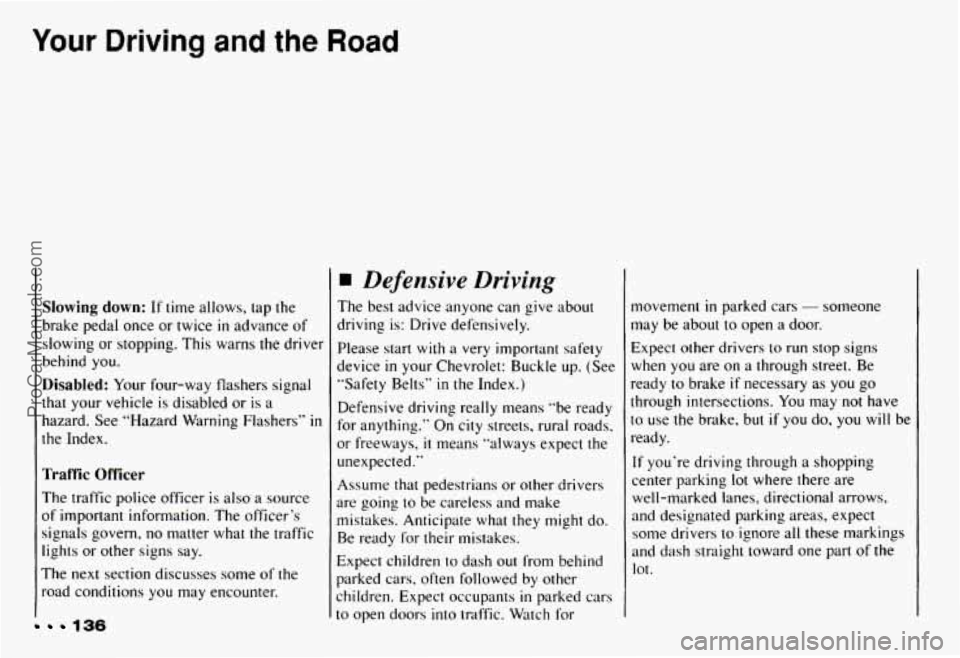
Your Driving and the Road
136
Slowing down: If time allows, tap the
brake pedal once or twice
in advance of
slowing or stopping. This warns the driver
behind you.
Disabled: Your four-way flashers signal
that your vehicle
is disabled or is a
hazard. See “Hazard Warning Flashers”
in
the Index.
Traffic Officer
The traffic police officer is also a source
of important information. The officer’s
signals govern, no matter what the traffic
lights or other signs say.
The next section discusses some of the
road conditions you may encounter.
Defensive Driving
The best advice anyone can give about
driving
is: Drive defensively.
Please start
with a very important safety
device
in your Chevrolet: Buckle up. (See
“Safety Belts”
in the Index.)
Defensive driving really means “be ready for anything.“ On city streets,
rural roads,
or freeways, it means “always expect the
unexpected.”
Assume that pedestrians or other drivers
are going
to be careless and make
mistakes. Anticipate what they
might do.
Be ready for their mistakes.
Expect children
to dash out from behind
parked cars, often followed
by other
children. Expect occupants
in parked cars
to open doors into traffic. Watch for movement
in parked cars - someone
may be about
to open a door.
Expect other drivers
to run stop signs
when you are
on a through street. Be
ready
to brake if necessary as you go
:hrough intersections.
You may not have
:o use the brake, but if you do, you will be
-eady.
If you’re driving through a shopping
center parking
lot where there are
well-marked lanes, directional arrows,
and designated parking areas, expect
some drivers to ignore all these markings
and dash straight toward one part of the
lot.
ProCarManuals.com
Page 163 of 358
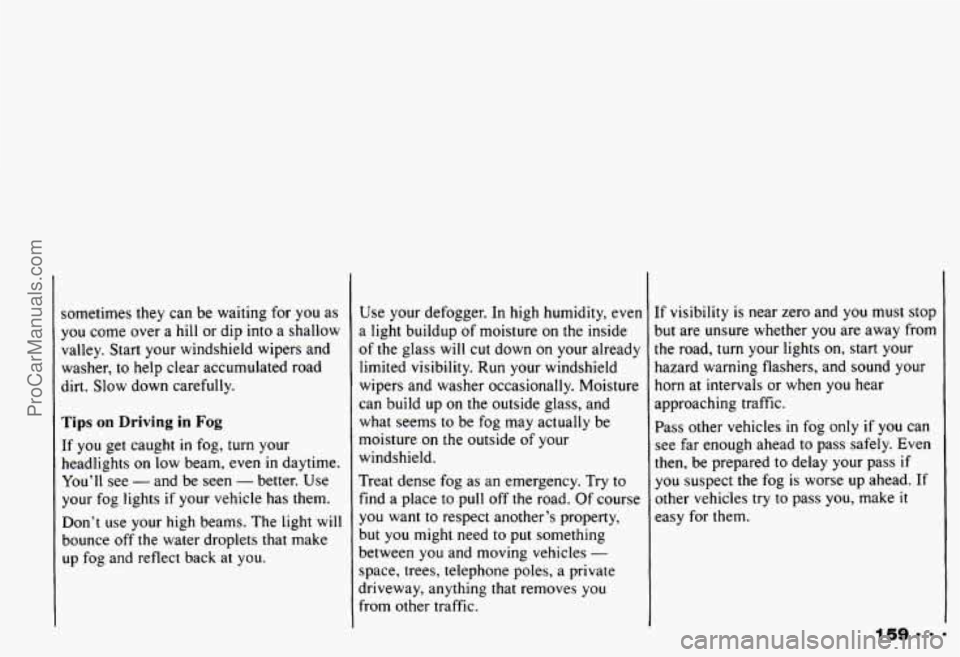
sometimes they can be waiting for you as
you come over a hill or dip into a shallow
valley. Start your windshield wipers and
washer, to help clear accumulated road
dirt. Slow down carefully.
Tips on Driving in Fog
If you get caught in fog, turn your
headlights on low beam, even
in daytime.
You’ll see
- and be seen - better. Use
your fog lights
if your vehicle has them.
Don’t use your high beams. The light will
bounce off the water droplets that make
up fog and reflect back at you. Use
your defogger. In high humidity, even
a light buildup of moisture on the inside
of the glass will cut down on your already
limited visibility. Run your windshield
wipers and washer occasionally. Moisture
can build up on the outside glass, and
what seems to be fog may actually be
moisture on the outside of your
windshield.
Treat dense fog as an emergency. Try to
find a place to pull off the road. Of course
you want to respect another’s property,
but you might need to put something
between you and moving vehicles
-
space, trees, telephone poles, a private
driveway, anything that removes you
from other traffic.
[f visibility is near zero and you must stop
but are unsure whether you are away from
the road,
turn your lights on, start your
hazard warning flashers, and sound your
horn at intervals or when you hear
approaching traffic.
Pass other vehicles in fog only if you can
see far enough ahead to pass safely. Even
then, be prepared to delay your pass if
you suspect the fog is worse up ahead. If
other vehicles try to pass you, make
it
easy for them.
ProCarManuals.com